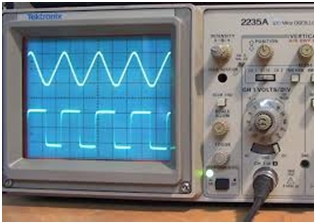Next part of the “Measuring instruments” tutorial series. Enjoy!
So here we are with another measuring instrument. The one which I have chosen for today concludes all our measuring instruments in a much esteemed way. Yes, I am talking about the oscilloscope, which would be justified to explain now as we have already been through all of its components like voltmeter, ammeter, distortion meter etc.
Now you may be wondering that why I am referring to these instruments as components of the oscilloscope. The answer to your question is pretty simple and straight forward. This is because an oscilloscope contains all these instruments and has the ability to measure each quantity and not only the quantity but also display its waveform changing with time. And this is the actual specialty of this instrument through which it is usually defined.
What is an Oscilloscope?
So an oscilloscope is an instrument that can measure different electrical quantities like voltage, time, frequency, current etc and help you observe them by giving you a graphical display of each quantity as a function of time, as shown below:
Through this definition, two things should be note. First that we can measure a number of quantities, almost all the basic ones and the ones of who’s instruments we have studied, through an oscilloscope.
Secondly, we can observe these quantities in graphical form changing from time to time and their graphical properties as well. This does not mean that we cannot measure them digitally through an oscilloscope. Digital display in the form of numeric digits is also available.
How does an oscilloscope work?
Now the question that might be arising in many of your minds is that how does it happen, that we see a fully moving live graph on this small and compact device. But the principle is pretty simple, and I’ll be explaining it through the help of the example of a television.
Most of us are familiar with how televisions work. The back screen of the television is coated with phosphors. An electron beam is generated and received and when it hits the back side on this coated screen, the electrons hit the coating and at all the places where the electrons strike, the coating lights up there. At every instant a different beam of electrons keep hitting and all of this process occurs so rapidly, that as a result of this we see a moving picture on the screen which is indeed a combination of the different beams of electrons hitting the coated screen one after the other.
Now an oscilloscope also works in the similar fashion. The electron beam is generated from a cathode ray and hits the screen as a result of which we see a moving graph on the screen. Due to this reason the oscilloscopes are also sometimes referred to as Cathode ray oscilloscopes.
Measuring with an oscilloscope
We know that oscilloscopes can measure electrical quantities like current, capacitance inductance etc, and display their graph. But what if we want to see the graph of a sound wave or something non electrical like that? For this purpose the CRO will first convert that quantity to a voltage signal and then display its graph.
Uses of an Oscilloscope
- Oscilloscopes are very useful in troubleshooting electrical circuits because they not only tell about the amplitude of the quantity but also display through the graph if the waveform is fluctuating or oscillating or if there is any other such problem.
- They are used in signal modulation circuits to carefully see and check the different types of waves produced.
Conclusion
This was all about the oscilloscope, its working and uses. I hope it was helpful for you.
If you want to learn more about this stuff keep visiting us and I will be most happy to be of any service for you.
Thanks for reading me,
Nasir.
Did you learn more on oscilloscope or do you want to complete Nasir’s explanations?


